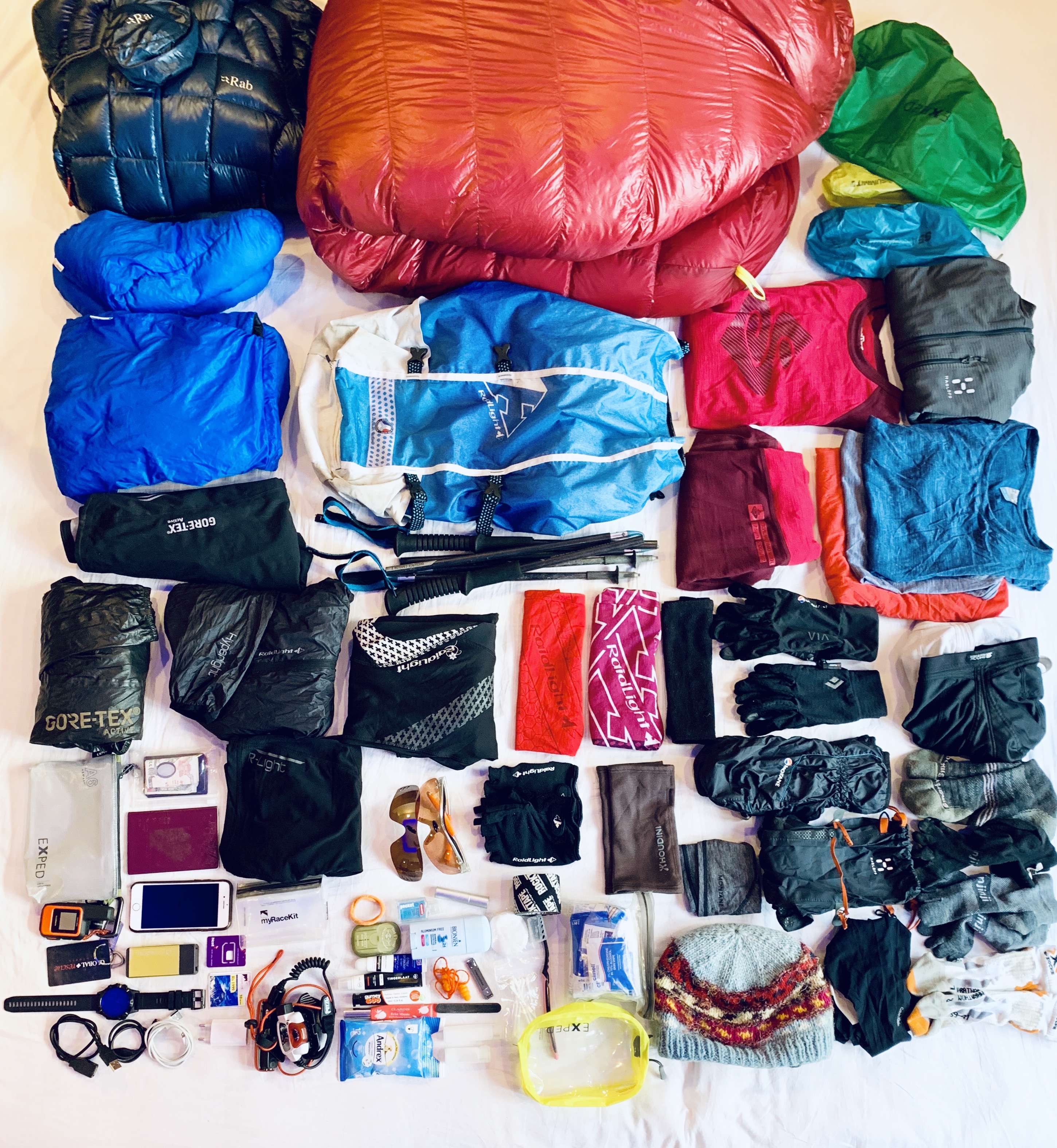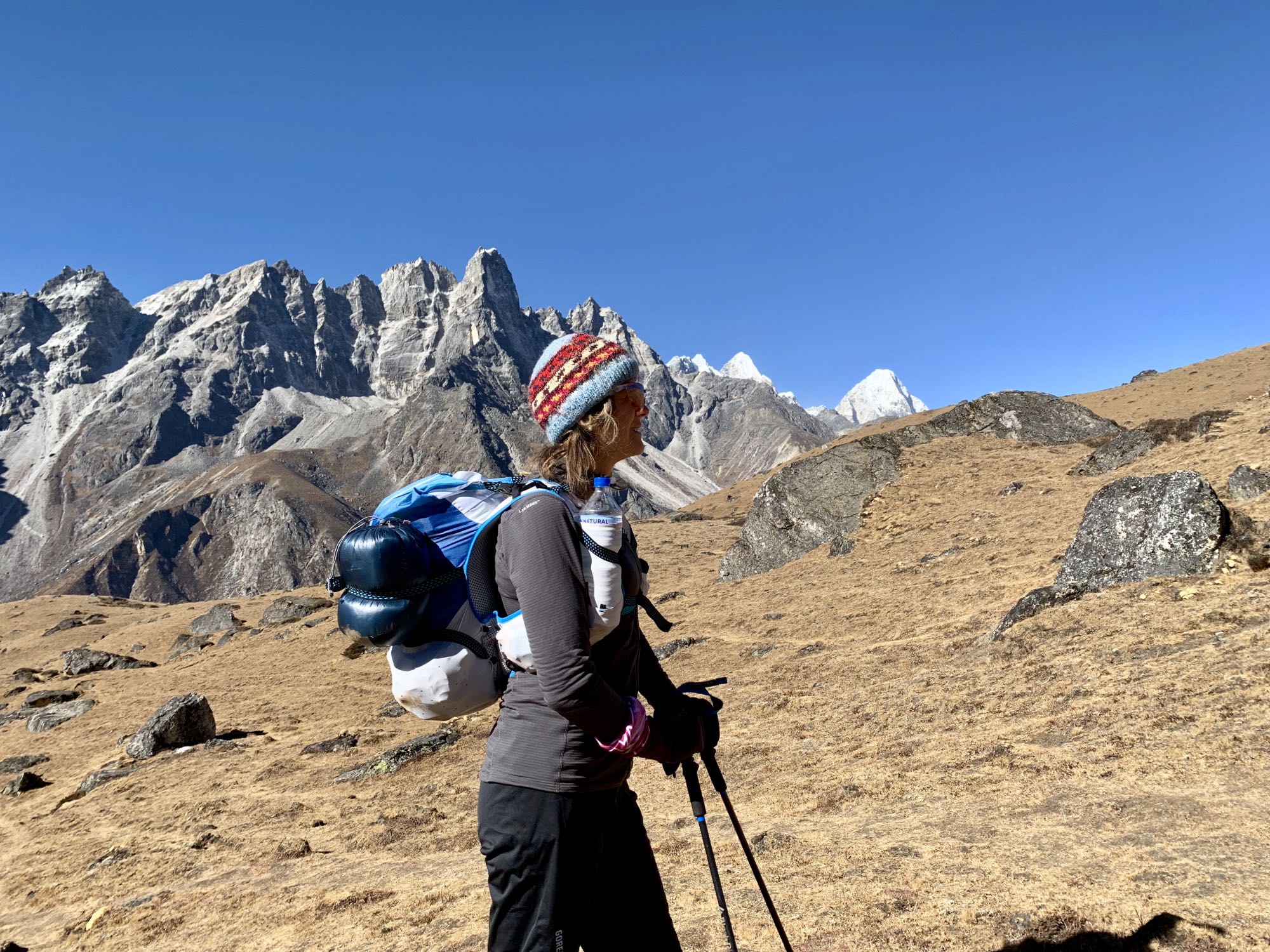In November 2018 Sondre Amdahl and I did the popular Three Passes Trek in the Himalayas of Nepal. We didn’t have any porters or guides, and we carried all of our equipment ourselves. Apart from some healthy energy bars and snacks which we brought with us (knowing the supply would be limited), we bought all our food and drink along the way and we stayed in lodges.
Here follows the kit list of what I took for this trek. The combined weight was approximately 7kg and I had more than I needed. Most trekkers carry far too much. It is not uncommon to see people with twice or three times as much. If you have a porter of course you can get them to haul around a great deal of luggage around the mountain but why should you? If you carry it yourself, trust me: at 5000+ metres of elevation, on steep ascents or descents, this is not much fun! Going light gives you freedom and there is really not very much you need as long as what you bring is functional and fit for purpose.
This kit list is similar to what we had for our fast hiking trip to Everest Base Camp and it can apply to any similar trek and also to the Everest Trail Race (ETR). However if you do a race you should scrutinise the list and shave a few things off to get the pack weight down further. I would recommend around 5kilos for the Everest Trail Race for example. The main difference between doing the Three Passes Trek, or indeed the Everest Base Camp Trek, and doing the Everest Trail Race, is the elevation. During the Three Passes Trek you spend a significant amount of time around or over 5000m elevation. As such you need some warmer clothing, some of which you don’t need if you race ETR, particularly not all the gloves and mitts I had, but I did use them all on our trek.
We did this trip in November. Research the weather conditions for your chosen time of year and adjust accordingly. If you plan to do your trek in winter with snow and ice this demands different equipment.
In order to achieve a light weight you need too look at high quality materials, particularly high fill power down for the sleeping bag and jacket. If you don’t, or if you prefer synthetic alternatives, you have to carry more weight and more volume so you will need a bigger backpack than what I suggest here.

Footwear & socks
- A pair of reasonably robust trail running shoes. They should fit well on your feet and you should know that you can go uphill and downhill in them for long durations without issues. Good grip is an advantage as some of the terrain is technical. Hiking boots are in my opinion completely unnecessary unless you have problems with ankle stability or carry a very heavy load. If you want to move fast and combine running and hiking you need trail running shoes.
- Crampons for Cho-La Pass (Three Passes Trek) as you will cross a glacier (we didn’t have this but it is strongly advisable that you do). Light-weight micro-spikes will do.
- Smartwool PhD Outdoor Light Cushion women’s socks – 1 pair
- Injinji toe socks – 2 pairs
- X-socks Marathon socks
- (Consider max 3 pairs of socks if you race)
Sleeping
- Lightwave Firelight 650 (excellent quality and warmth to weight ratio) I have also used this bag for Everest Base Camp in December and for Everest Trail Race. You could also consider the version below which is the Firelight 550, or the Yeti Passion Five, Particularly for ETR.


Backpack
- A running backpack / large vest-style pack of approximately 25 litres is a good option here. Examples include (current models Nov 2019) Ultimate Direction Fastpack 25l or 35l, OMM Phantom 25l. Options here.

Clothes
- GoreWear ShakeDry R7 jacket or equivalent light weight Gore-Tex jacket or similar. I recommend a jacket with good quality fabric, yet light weight.
- Light weight good quality running T-shirt. I opted for a light merino mix fabric. I took two T-shirts but one would suffice.
- Long sleeved light weight Merino base layer shirt. I took two of these in order to be able to use one for the day and one in the lodge in the afternoon/evening plus as pyjamas in the sleeping bag.
- Light weight Polartec fleece (perfect mid layer for both running and rest but I did not use this in ETR).
- Merino 3/4 leggings for use in the afternoon/evening and in the sleeping bag as pyjamas.
- Long running tights
- Short running tights or shorts (only relevant at the lower elevations and depending on what time of year you do your trip)
- RAB Infinity G Down Jacket (extremely good warmth for weight – Men: check out the impressive Zero G jacket!)
- GoreWear Gore-Tex overshorts. These are much more practical to run in than long trousers and perfect wind-shield when it gets colder. Not necessary for ETR.
- Primaloft Mitts
- Merino liner glove or Polartec thin fleece liner glove
- Haglofs Gore-Tex Shell Mitts (excellent but no longer part of the range sadly – check out the Montane Minimus Mitt for a great alternative)
- Montane Via Trail Glove
- Montane Primino Beanie
- Underwear: Calvin Klein Invisibles thong (extremely light, laser cut and chafe free!) – 1 pair per day.
- Shock Absorber N109 Sports Bra x2. One for running, one for resting.
- Buff / neck scarf x2
- Fleece buff (old, have had for ages)
- Astucas Sestral Pants (synthetic insulation, very warm and useful for both moving in and for resting)
- Astucas Foratata Socks (Down Booties – to keep feet warm when in the lodges)
- Sziols X-Kross Sun glasses (my choice of sun glasses since 2011 for all my races and adventures. Simply the best.)
- Knitted wool beanie (bought in a lodge en route as it got cold above 4000m)
- Houdini fleece wrist warmers
- Thin wind jacket (a light weight waterproof can serve the same purpose)
- If your trek is in a season with rain you should have waterproof pants but I have never needed this in Nepal in November and December.


Electronics
- Head Torch Petzl Nao+ 750 lumen (if you race ETR you should opt for a smaller and lighter head torch as you will not use it much in the dark)
- iPhone with protective cover and charge cable (do not take if you race as it is unnecessary weight)
- Ncell SIM card with data preloaded (bought in Kathmandu)
- Everest Link Wifi pre-paid cards – purchase in the lodges when the mobile coverage ends.
- GPX watch with gpx route loaded and charge cable
- Charger Goal Zero Flip 20 (very reliable, even in the cold)
- 1 x Euro wall plug with USB socket
- Garmin InReach Mini Satellite Tracker. This is a very small weight sacrifice for the extra safety it provides.

Personal care and various other items
- Sea to Summit multi-purpose soap leaves
- myRaceKit personal Care Travel Kit
- Small first aid kit, a variant of the myRaceKit Footcare Deluxe Kit
- Rocktape H2O
- Gurney Goo x 2 small tubes
- Victorinox Alox multitool with scissors and knife
- Medications. I recommend you pack Ciprofloxacin in case of diarrhoea, and also Imodium. Consider Diamox for altitude sickness though it is banned by WADA (to be aware of if you race) and has side effects (I didn’t use it). Be aware that Ibuprofen is not recommended to take with strenuous exercise due to potential kidney damage. Paracetamol is better for pain. However, don’t take pain killers to mask signs of altitude sickness, be aware of the symptoms and what to do. There is ample supply of medications in pharmacies in Lukla and Namche Bazar.
- Small travel toilet roll (toilet roll can be bought along the way in shops and lodges to resupply)
- Feminine hygiene wipes & toilet wipes travel pack (optional obviously and perhaps more for the ladies)
- Nail clipper
- Sun cream small pack
- Deodorant and Eau de Toilette in small travel spray container from Muji (not necessary and definitely don’t take this for a race)
- Lip balm (lips quickly get dry from sun and altitude)
- Travel towel for taking showers and washing
- Hand Sanitiser 30 ml (included in the Personal Care kit mentioned above) – Hygiene is super important!
- Passport
- Credit cards (Visa is more widely accepted than MasterCard).
- Cash, see practical notes in my Three Passes Trek blog.
- Sea to Summit Ultra-Sil dry sack 20L-30l plus a couple smaller ones used as backpack liner and for organising kit plus water protection
- Zip-lock bags and/or waterproof pouches for electronics and toiletries
- You can take water bottles or a bladder but it is just as easy to use the PET bottles you buy water or soda in and put in the water bottle holders on your backpack.
- Black Diamond Distance Carbon Z-Poles
- Probiotics and Vitamins (according to personal preference – if you normally take something, bring it along)
- Nescafe Espresso Instant coffee in zip lock bag – to top up coffee strength – I like my coffee strong 🙂
- Specialist travel insurance for extreme sports. ALWAYS check with your insurance provider what is covered. Standard travel insurance in some countries, like the UK, does NOT cover trekking at the elevations relevant here.
- Helicopter rescue insurance unless covered in your travel insurance, check carefully. If you are not covered for this you can buy this insurance from Global Rescue



Food
You can buy all food, snacks, water and drink at regular intervals along the way. As such it is not necessary to carry food in advance unless you have specific dietary requirements. The quality of snacks you can buy is typically limited to “junk food” such as Snickers, Mars bars and crisps. If you want something healthier it can be a good idea to bring it. Dried fruit and nuts is available in some shops, particularly in Namche Bazar.
